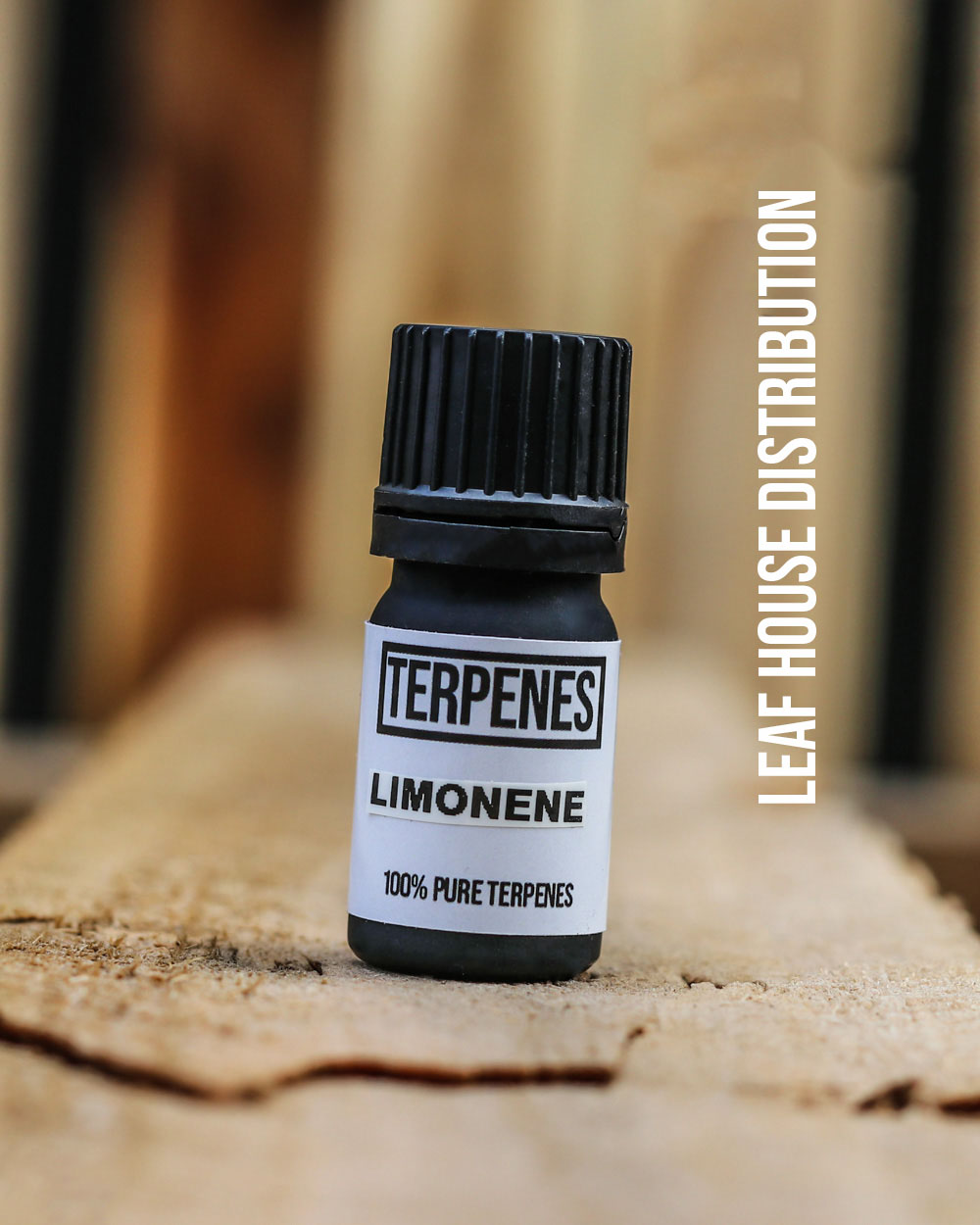LIMONENE – TERPENE ISOLATE – 5ML
Limonene is a vibrant and aromatic terpene known for its distinct lemon-like scent. This colourless, oily liquid is predominantly found in the rinds of citrus fruits such as lemons and oranges, where it contributes to their refreshing, zesty aroma.
CUSTOMERS WHO VIEWED LIMONENE ALSO VIEWED
PROPERTIES: LIMONENE
| COLOUR: | Colourless |
| CONSISTENCY: | Liquid, Oily |
| ODOUR: | Citrus |
| BOILING POINT: | 176ºC |
| FLASHPOINT: | 48ºC |
| SOLUBILITY: | In Water, 13.8 mg/L at 25ºC |
| FORMULA: | C10H16 |
| DENSITY: | 0.8411 g/cm³ at 20ºC |
| MOLECULAR WEIGHT: | 136.238 g/mol |
WHERE DOES LIMONENE COME FROM?
Limonene is one of the most abundant terpenes in nature and is primarily extracted from the peels of citrus fruits. At room temperature, it remains a clear, colourless liquid that is widely recognised for its strong citrus scent. Due to its pleasant aroma, limonene is a popular ingredient in a variety of consumer products, ranging from cleaning agents to fragrances. Plants that contain Limonene include:
01
LEMONS
02
ORANGES
03
GRAPEFRUITS
04
LIMES
05
MANDARINS
WANT TO KNOW MORE ABOUT LIMONENE?
Download the Certificate of Analysis (COA) to get more detailed information about the ACDC Blend.
Learn the difference between Terpenes Isolates, Blends and Diluents.
APPLICATIONS OF LIMONENE
Limonene is frequently utilised in an array of household and personal care products. Its refreshing citrus fragrance makes it a favoured choice in bath products, air fresheners, and perfumes. Additionally, limonene is commonly used as a flavouring agent in foods and beverages, imparting a fresh, citrusy taste.
GUIDANCE ON USING TERPENE ISOLATE
When using terpene isolates like limonene, the method and quantity added to various formulations are matters of personal preference. However, due to the concentrated nature of pure terpenes, it is advisable to conduct thorough research before incorporating them into your concoctions.
WHAT’S THE LIMONENE MOLECULE LOOK LIKE?
WHAT ARE TERPENES USED FOR?
Terpenes are versatile compounds widely used in various industries due to their aromatic qualities. They are key components in aromatherapy, essential in creating complex scents for fragrance and flavors, and are commonly used in cleaning products for their natural properties. Terpenes also enhance personal care products and serve as natural alternatives in insect repellents and agricultural applications as natural pesticides.
AROMATHERAPY
Terpenes are key components in essential oils, which are widely used in aromatherapy. They contribute to the distinctive scents and potential therapeutic effects of these oils. For example, linalool, commonly found in lavender, is often used to promote relaxation and reduce stress.
FRAGRANCE AND FLAVOURS
In the fragrance industry, terpenes are essential for creating complex and appealing scents in perfumes and colognes. Terpenes like limonene, which has a citrusy aroma, are popular for adding fresh and uplifting notes. Additionally, terpenes are used as natural flavourings in food and beverages, enhancing products with citrus, herbal, or fruity flavours.
CLEANING PRODUCTS
Terpenes such as limonene are frequently included in natural cleaning products. They provide a pleasant scent while also offering natural grease-cutting abilities, making them effective in eco-friendly cleaning solutions.
PERSONAL CARE PRODUCTS
Many skincare and personal care products incorporate terpenes for their aromatic properties and potential skin benefits. For instance, linalool is often added to lotions and creams for its soothing fragrance and possible calming effects on the skin.
INSECT REPELLENTS
Some terpenes, like citronellol and valencene, are utilised in natural insect repellents due to their ability to repel mosquitoes and other pests. These terpenes are valued for providing a safer, chemical-free alternative to synthetic repellents.
AGRICULTURAL APPLICATIONS
In agriculture, terpenes are sometimes used as natural pesticides to deter insects and other pests. Terpenes like beta-caryophyllene are known for their insect-repellent properties, making them a valuable tool in sustainable farming practices.
















Reviews
There are no reviews yet.